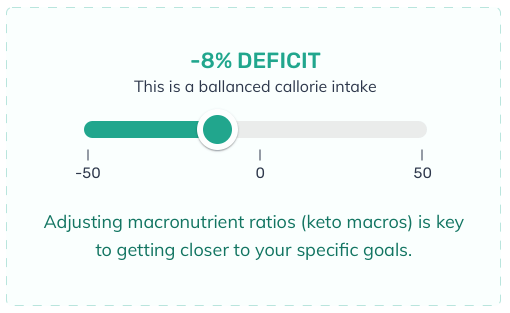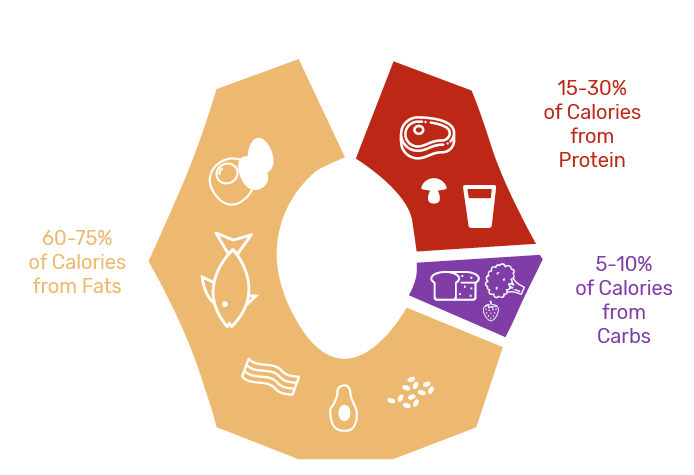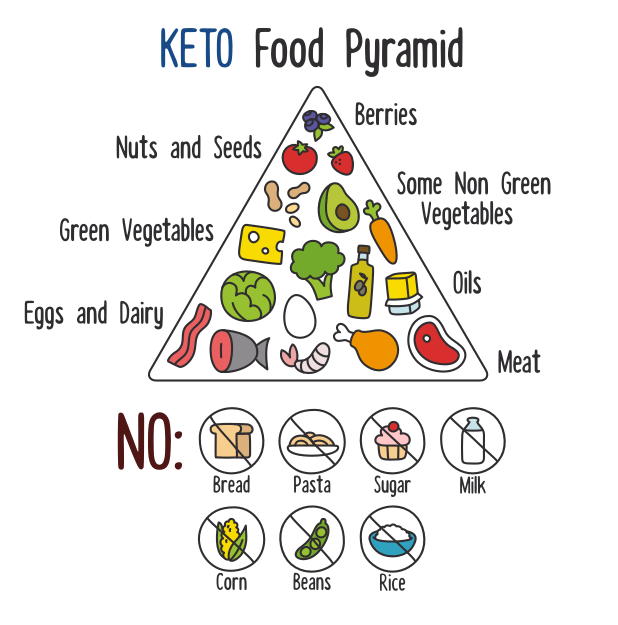

Ambassador spotlight Janet Bolger
Are you starting on a ketogenic diet and want to calculate your macros? Our easy-to-use keto calculator calculates your personal macros to help you reach ketosis. Simply input your attributes and goals and find out how to eat to get into ketosis.
Do you want to lose, maintain, or gain weight? Select an estimated percentage of calorie deficit, balance, or surplus, and our calculator will tell you how much fat you need to eat to reach your goal. Keep in mind that it is always best to stay within a 30% calorie deficit to a 15% calorie surplus limit. Going beyond these limits can create problems in the long run.
Grams per day:
Fat 0g
Protein 0g
Carbs 0g
Calories 0
Grams per meal:
Fat 0g
Protein 0g
Carbs 0g
Calories 0
The numbers above are your personalized keto macros presented in grams per day and per meal. There’s also a formula to help you calculate your daily calories. Fat provides 9 calories per gram, while carbohydrates and protein provide 4 calories per gram. Use this info to calculate the calorie intake for each macro.
For example: if your recommended daily carb intake is 30 grams, multiply that by 4 (calories per gram) and you get a daily limit of 120 calories for carbs (30 X 4 = 120).
Our keto macro calculator helps calculate your ideal keto macros based on your TDEE and your goals. TDEE stands for Total Daily Energy Expenditure, and it’s a measure of how many calories you burn per day.
To calculate your TDEE, our calculator uses the following factors:
Besides your TDEE, our keto calculator will also determine your Basal Metabolic Rate (BMR).
BMR is the rate at which your body burns calories at rest, i.e. calories you burn while doing nothing.
Knowing your BMR will help you determine how many calories you should be eating to lose, gain, or maintain weight.
In addition to using your TDEE and your BMR, our keto macro calculator uses your dieting goals to calculate which keto macros will help you achieve said goals. Not all keto-ers want to lose weight. Some want to gain mass and others want to maintain their current weight.

Another important feature of our keto calculator is that it provides keto macros only for the Standard Keto Diet (SKD).
The SKD takes a fairly universal and specific approach to the amounts of protein and fat you should eat. For both, intake is within the following ranges on a SKD:
Our keto calculator will provide protein and carbohydrate amounts within these ranges no matter your age, gender, activity levels, and intensity of your workouts. However, you may notice greater variations in the recommended fat intake our calculator provides. That’s because the SKD is fairly flexible when it comes to fat intake. On this diet, how much fat you should eat is determined by how many calories you should eat.
After you click on the “calculate my macros” button you will get these three results at the bottom of our keto calculator:
To see if you are sticking to the recommended keto macros and calorie intake, it’s best to use dieting apps such as My Fitness Pal, which offer a huge database of calories and macros in food.
A one-size-fits-all approach does not work when it comes to keto macros. Sure, there are some universal principles you should follow on a keto diet (e.g. restricting carbs), but we need to take our many differences into account to achieve best results. That’s why our keto macronutrient calculator considers factors such as age and weight. Here is how each factor determines your results.
Research shows that age plays huge role in how many calories you burn at rest 1. In other words, your BMR changes as you age. The main reason behind this is the gradual loss of muscle mass that comes with aging. Muscles happen to be the greatest spenders of energy in your body, and their loss with aging lowers your body’s total energy spending.
Your gender (i.e. sex) also plays a big part in how many calories you burn. Researchers found that, in general, men burn more calorie than women, meaning they have a higher BMR 2. That’s because men have more muscle mass than women on average.
Having excess weight usually means having an unfavorable body composition. Put differently, being overweight usually means having more fat than muscle. More fat and less muscle lowers your BMR, which makes burning calories difficult and that’s why more weight will mean you’ll need to eat fewer calories on your keto diet.
Your height is an important measurement in determining your body mass index when used in relation to your weight. Once you’ve provided your height and weight, our keto calculator will determine your estimated BMR and TDEE.
Two people can have the same height and weight but a completely different body composition as defined by their body fat percentage. Having too much body fat can lower your BMR as can having too little body fat.
Here is how body fat percentage varies among people based on information from various research:
| Rating | Men | Women |
|---|---|---|
| Low | <5% | <15% |
| Very lean | 5-8% | 15-18% |
| Lean | 9-12% | 19-22% |
| Ideal | 13-20% | 23-30% |
| Excessive | 21-30% | 31-40% |
| High (obesity) | >30% | >40% |
With these estimates taken into account, our keto macros calculator will provide fewer calories and fat if you input a higher body fat percentage than if you have a low body fat percentage.
To determine your body fat percentage, you can:
Your activity levels, as well as the intensity of your activities, contribute greatly to your TDEE. If you’re sedentary, your body will burn fewer calories than it would if you were highly active. That’s why our calculator will suggest more calories when you’re active than when you’re sedentary.
Simply put, a calorie deficit refers to how many calories you need to eat less of to lose weight, while a calorie surplus refers to how many calories you need to eat more of to gain weight.
Calories still matter on keto, and your daily intake will determine your end results. That’s why we’ve included the estimated calorie deficit/surplus you will need to achieve a defined goal (losing, maintaining, or gaining weight).
A calorie deficit/surplus can be large, moderate, or small:
We suggest not going beyond a 30% deficit and a 15% surplus to support overall health. Gaining or losing weight too quickly due to extreme calorie intake can sabotage your success. In some cases, it can even be life-threatening 3. If you want to maintain your current weight, then eat the calories you’re currently taking in.
Most of your these calories will be from fat. However, carbohydrate and protein will also provide a significant calorie deficit/surplus and that our keto calculator will estimate based on your activity levels, TDEE, and BMR.
And in case you’re wondering who would want to gain weight on a keto diet, the short answer is athletes and bodybuilders. The weight these categories want to gain is mostly muscle mass, and their calories should come from all three macronutrients at different proportions. However, a rare bunch of keto-ers may also want to gain body fat if underweight.
This calculator provides personalized keto macros. But what exactly are keto macros?
The term “keto macros” refers to the ketogenic macronutrient ratio, which is usually defined as:
Eating within this ratio puts the body in ketosis – the main goal of the ketogenic diet. The most important aspect of keto macros is restricting carbohydrates because this lowers blood glucose and insulin levels, both of which are necessary for the body to enter ketosis.
Furthermore, protein is restricted because too much of this macronutrient can kick you out of ketosis, and higher fat intake is encouraged because it promotes ketosis (more on both later).

You have to limit carbs on keto in order to achieve the main purpose of this diet, which is ketosis.
Ketosis is a metabolic state in which fat burning is upregulated in order to boost the production of ketones, alternative fuels to glucose. This can only happen when your carbohydrate intake is so low that your body has no other option but to start burning fat to keep up with its energy demands.
Based on years of research, researchers came to a 50g per day limit that seems to work for most people. To put this into perspective, one peanut butter and jelly sandwich has 46 g of carbohydrates. However, athletes and those with a higher muscle mass can and should eat slightly more than that without risking being kicked out of ketosis.
If you’re an average keto dieter, however, do avoid peanut butter and jelly and go for low-carb food such as:
Of course, food like butter, cream, meat, fish, and eggs are also low-carb. However, you probably already knew that. The more confusing part of going keto is knowing which plant foods are low enough in carbs to be keto friendly. Again, diet apps can help with this. You can also check out our list of low-carb vegetables to eat on keto as well as top keto diet fruits.
Limiting carbs is the number one priority of keto, but why do you need to eat so much fat if your body is meant to burn its own fat on this diet? That’s something most keto dieters have asked at some point. And the question is valid.
Put simply, you need to boost fat intake to avoid starving yourself. Without fat, a keto diet would be a starvation diet. But keto is not a starvation diet. In fact, it was primarily designed to replace fasting as therapy.
On this diet, fat has replaced carbohydrates as the main source of energy. Fatty food also helps support ketone production and helps you avoid nutrient deficiencies. Some dietary fats are also absolutely essential because your body cannot make them on its own but needs them for a wide range of functions. Examples of high-fat food to eat on keto include:
How much fat you should eat on keto depends on how many calories you need. If you need to eat fewer calories to boost weight loss, then you need to eat less fat than someone who needs to gain or maintain weight. This keto diet calculator will estimate your ideal daily and per meal fat intake based on your goals and your TDEE.
Make sure to include a variety of food in your weekly keto meal plan to prevent nutrient deficiencies. Many dieters make the mistake of sticking to a limited list of keto-friendly foods and, in this way, risk not getting all the fiber, vitamin C, minerals, and other nutrients they need to stay healthy.
Protein intake should be moderate on a keto diet. But what does moderate mean?
Generally speaking, moderate in this case means the following two things:
However, protein intake on keto depends a lot on your body mass and your activity levels. If you’re an athlete who wants to build lean mass, then our keto calculator will recommend a slightly higher protein intake. Protein intake should also be higher if you’re older to help minimize age-related muscle loss.
Like fat, protein is also an essential macronutrient. A total of 9 amino acids (building blocks of protein) are known to be essential to human health as they help with the following functions:
But now you may be wondering why you couldn’t just eat as much protein as you want. After all, protein is also satiating and known to help with weight loss. There’s actually a valid reason why protein intake needs to be moderate on keto, gluconeogenesis.
Gluconeogenesis is a metabolic pathway by which your body converts glucogenic amino acids from protein into glucose. That means that if you eat too much protein, there’s a big chance much of it will be converted into lots of glucose and this will kick you out of ketosis.
Now gluconeogenesis is taking place constantly on a keto diet to help maintain normal blood glucose levels 5. You just need to keep your protein intake optimal to avoid raising your blood sugar levels too much.
You’ve provided all the required data and our keto macro calculator has calculated your results. You may still be confused what those results mean and how you should interpret them. To clarify it for you, it’s best to explain things with a case example.
Meghan is 32. She’s 5’5” and weighs 143 pounds. She describes herself as lean and is quite active since she works as a nurse. Meghan does moderate cardio for 2 days a week for one hour daily.
Our keto calculator shows Meghan has a BMR of 1361 calories and a TDEE of 1966 calories.
Meghan defines her goal as wanting to maintain her current weight, so she sets the scale to 0%. When she clicks on “calculate my results, ” she gets the following keto macros:
Per Day
Per Meal
Meghan should aim to make her daily meals fit these keto macros. What that means is that the food she eats should provide nutrient ratios as suggested by her keto calculator results. Her per meal results help provide a picture of how her meals should look like. To learn how to make a meal plan that will fit you keto macros, read our free guide here.
Of course, activity levels and metabolic rate are not static for most people. There will be days where you’re more active and days when you’re barely lifting a finger. If you plan to lose weight with the help of keto, your calorie requirements will change over time as well. Our advice is not to look at the results given by this keto diet calculator as set in stone. Instead, use them as rough guidelines that will help you get started on your keto journey and feel free to make adjustments where you think is necessary.
Careful meal planning helps beginners hit their keto macros. First, you’ll need to make a list of keto-friendly foods you plan to eat. Secondly, you’ll need to make a keto meal plan.
It’s important that you have the macronutrient ratios for every meal calculated. You can do this manually by researching the nutritional info for each food with a focus on its macronutrients. However, a simpler approach is using dieting apps. All this may seem time-consuming and like exhausting work. And truth be told it is. However, keto dieters find that they are able to eat intuitively with time and practice.
To learn how to hit each of the three major keto macros, take a look at the tips below.
No need to be skimpy with the fat on keto. Make sure that every meal you eat has lots of fat. Add butter to vegetables and meat, drizzle olive oil and MCT oil over your salads, add nuts and seeds to yogurt, and, when in doubt, eat an avocado. Below are fat-rich foods to include.
Protein will be an important carrier of fat on your keto diet. Choose high-quality protein and go for food sources that are rich in both fat and protein. Avoid lean protein such as chicken breasts and cottage cheese.
You still need to eat carbs on keto. Some cells cannot run on fat or ketones (liver cells, kidney cells, red blood cells, and some parts of the brain). Carbohydrate-containing food is also the only source of dietary fiber, which you need for normal bowel functioning and immunity.
On keto, you should get all your carbs only from low-carb food. These foods are nutrient dense while being low in carbohydrate. They will give you the minimal amount of carbs you need with a helping of fiber and valuable nutrients. Keep in mind, though, that many high-fat keto diet foods like nuts, seeds, and avocados are also sources of carbohydrates.
The keto diet turns the food pyramid and your usual eating patterns upside down. Sticking to keto macros is tough and eating mostly fat (~80%) isn’t something you can switch to overnight. Luckily, there are countless tips and tricks that have worked for keto dieters everywhere and that we share here:
It’s important that you have the macronutrient ratios for every meal calculated. You can do this manually by researching the nutritional info for each food with a focus on its macronutrients. However, a simpler approach is using dieting apps. All this may seem time-consuming and like exhausting work. And truth be told it is. However, keto dieters find that they are able to eat intuitively with time and practice.

To learn how to hit each of the three major keto macros, take a look at the tips below.
Having sugary chocolate bars and pasta around is not a good idea on keto. Replace high-carb food with high-fat goodness and you’ll see that hitting your keto macros is easy.
We can’t emphasize this one enough. Dieting apps make going keto a whole lot easier. They do the majority of macros and calorie counting for you, so do have one on your phone for easy macros calculating.
Planning meals is a foolproof way to hit your daily macros. But it does take dedication and quite a bit of time. If you don’t feel like planning all your meals, then use ready-made meal plans and stick to those.
When hunger strikes, it’s best to go for a high-fat food to avoid overeating on carbs. String cheese, avocado slices, nuts, pork rinds, and butter coffee are always safe on keto.
Bread, pasta, beans, bananas, starchy vegetables, sugary fruit, and desserts are all examples of food that you need to forgo on keto. If you manage to avoid food that has more than 10g of net carbs per serving, you’ll get closer to hitting your keto macros on a daily.
You’ve been hitting your keto macros for some time now and want to check if your dieting attempts are working. In other words, you want to know if you’re in ketosis. There are two ways you can check for ketosis:
Ketone test strips check for ketones in urine. Having elevated levels of ketones in urine is a sure sign of ketosis, especially when you are just transitioning into this metabolic state. There are other ways to test for ketones such as using a ketone breathalyzer or ketone blood meter. However, these are expensive and not necessary for the average keto-er.
When you start transitioning into ketosis, you’ll definitely notice. Ketosis comes with a plethora of signs and symptoms, some subtle and others, not so much. Check for these 9 signs of ketosis to see if your diet is paying off.
Shimokata H, Kuzuya F. [Aging, basal metabolic rate, and nutrition]. Japanese Journal of Geriatrics. 1993;30(7):572-6. https://www.ncbi.nlm.nih.gov/pubmed/8361073
Garn SM, Clark CL, Harper RV. The Sex Difference in the Basal Metabolic Rate. Child Development. 1953; 24(¾): 215-224. https://www.jstor.org/stable/pdf/1126247.pdf?seq=1#page_scan_tab_contents
Lapinskienė I, Mikulevičienė G, Laubner G. Consequences of an extreme diet in the professional sport: Refeeding syndrome to a bodybuilder. Clinical Nutrition ESPEN. 2018;23:253-255. https://www.ncbi.nlm.nih.gov/pubmed/29460810
Wolfe RR, Cifelli AM, Kostas G. Optimizing Protein Intake in Adults: Interpretation and Application of the Recommended Dietary Allowance Compared with the Acceptable Macronutrient Distribution Range. Advances in Nutrition. 2017;8(2):266-275. https://www.ncbi.nlm.nih.gov/pubmed/28298271
Azzout-Marniche D, Gaudichon C, Tomé D. Dietary protein and blood glucose control. Current Opinion in Clinical Nutrition & Metabolic Care. 2014 Jul;17(4):349-54. https://www.ncbi.nlm.nih.gov/pubmed/24839951